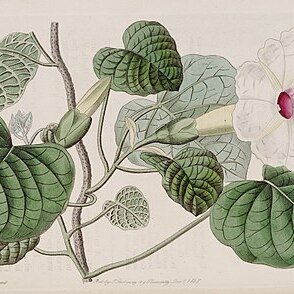Climbing shrub; stems slender, subwoody, trailing, finely pubescent.. Leaf-blade entire, rounded-ovate to oblong-ovate, up to 12.5 cm. long and 17.5 cm. wide, cuspidate or emarginate at the apex, ± cordate at the base, glabrous above but with a finely granular tomentum beneath, reticulate beneath when young due to a dense tomentum on the main nerves; petiole 3.8–7.5 cm. long.. Flowers few in a lax cyme; peduncle short; bracts obovate, deciduous, 1.6 cm. long.. Sepals broadly oblong, subequal, 1.5 cm. long, very obtuse, thinly covered with scattered tomentum, strongly reflexed in fruit.. Corolla white, funnel-shaped, 8.8 cm. long, glabrous.. Capsule 16–22 mm. long, 12–16 mm. diameter.. Seeds brown, 7–9 mm. long, covered with very long whitish hairs.
A climbing shrub. It grows 10 m long. The stems are slender. The leaf blades are almost round. They are large, velvety and heart shaped. They have white hairs on the veins. The flowers are funnel shaped and white but pale pink or yellow in the throat. They are 8 cm across. They open at night and close at midday. They have a sweet scent. The fruit are woody capsules. The seeds are covered in white threads.
Leaf lamina circular ovate to oblong-ovate, up to 13 × 16 cm., cuspidate or emarginate at the apex, more or less cordate at the base, entire to sinuous or somewhat crenate, when very young covered on both sides with a white floccose tomentum, reticulate beneath due to a dense tomentum on the main nerves and veins, glabrescent, petiole slender, 3·5–7·5 cm. long, white tomentose.
Climbing shrub, with white somewhat floccose tomentum. Leaves glabrescent beneath, becoming reticulate owing to dense tomentum on main nerves and veins. Flowers 65-145 mm long. Sepals broadly oblong, 15 mm long. Seeds with long hairs. Flowers white, cream or yellowish with mauve tube.
Sepals subequal, broadly oblong, 1·5 cm. long, obtuse, chartaceous, thinly covered with scattered tomentum, glabrescent, generally retaining the pubescence longest at the base, in fruit ultimately spreading to reflexed.
Flowers few in a lax cyme; peduncle short, tomentose; pedicels short, tomentose; bracts obovate, 1·6 cm. long, floccosely tomentose outside, deciduous.
Seeds brown densely covered with very long whitish cottony hairs, giving the dehisced capsule the appearance of a ripe cotton ball.
Climbing shrub up to 10 m. long, close to the following species but distinct because the different indumentum and distribution.
Stems slender, trailing when young herbaceous with white somewhat floccose tomentum, soon glabrous, older ones becoming woody.
Corolla funnel-shaped, White, cream or yellowish, with mauve tube up to 14·5 cm. long, glabrous.
Capsule 1·6–2·2 cm. long, apiculate, glabrous.

